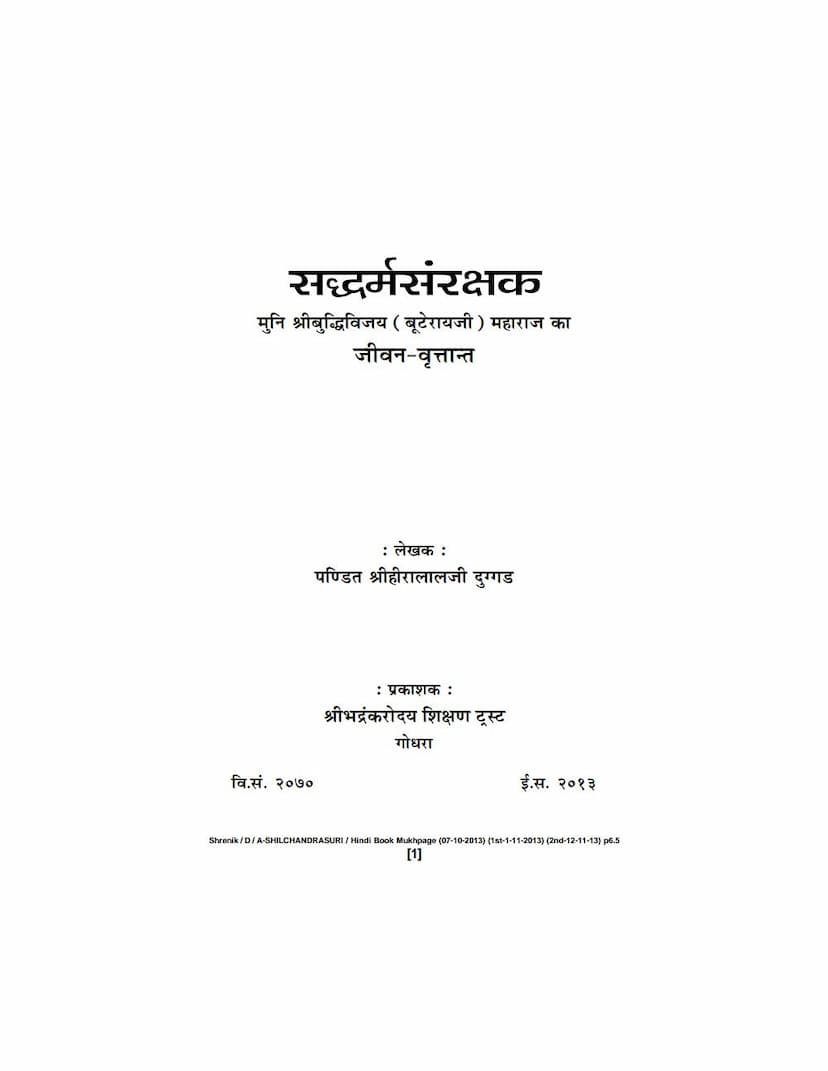Saddharma Sanrakshaka Muni Buddhivijayji Buteraiji Maharaj Ka Jivan Vruttant
Added to library: September 2, 2025

Summary
Here's a comprehensive summary of the Jain text "Saddharma sanrakshaka Muni Buddhivijayji Buteraiji Maharaj ka Jivan Vruttant" by Hiralal Duggad:
This book chronicles the life and teachings of Muni Shri Buddhivijay (Buteraiji) Maharaj, a prominent Jain ascetic. The narrative highlights his lifelong quest for truth, his struggles against religious dogma and corrupt practices, and his ultimate contribution to the revival and dissemination of pure Jainism.
Key aspects of his life and the book's content include:
-
Early Life and Renunciation: Born in Punjab in a Sikh family, Buteraiji (originally named Tal Singh, then Dal Singh, and later Buta Singh) experienced a profound spiritual awakening. Despite a comfortable upbringing and the loss of his father at a young age, he renounced worldly possessions and embarked on a spiritual quest. His early life was marked by the search for a true spiritual guide, exploring various religious paths before finding his calling in Jainism.
-
Disillusionment with Existing Practices: Initially, he received initiation into the Sthana-kavasi sect. However, through diligent study of Jain scriptures like the Acharanga and Suyagada Sutras, he discovered significant discrepancies between the monks' practices and the original teachings. He noted deviations in rituals and beliefs that led him to question the authenticity of their path.
-
Quest for the True Path: Buteraiji's quest continued as he encountered different Jain sects, including the Terapanth. He critically analyzed their doctrines and practices, always seeking to align with the original teachings of Lord Mahavir. His dedication to truth led him to challenge established norms, even when it meant facing opposition and criticism.
-
Embracing Core Jain Principles: A significant turning point in his life was his realization that the prevailing practices of many Jain monks, particularly regarding the Mukhapatti (mouth cloth) and the acceptance of Jina Pratimas (images of Tirthankaras), were not supported by the foundational Jain Agamas. Through scriptural evidence, particularly from the Vipak Sutra and Bhagavati Sutra, he argued that the continuous wearing of the Mukhapatti with strings tied to the ears was not an original Jain practice. He advocated for holding the Mukhapatti by hand during speech or scripture reading, a practice he believed aligned better with the Agamas and avoided potential harm to life. He also championed the worship of Jina Pratimas, seeing them as a means to devotion and karmic purification, supported by numerous scriptural references mentioning the worship of Jina images by deities, saints, and householders.
-
Challenging Corruption and Promoting Purity: Buteraiji's journey was fraught with challenges. He confronted the corruption prevalent among some Jain monks (Yatis and Pujyas) who deviated from ascetic principles, engaged in worldly pursuits, and distorted religious teachings for personal gain. His efforts to uphold the purity of Jain conduct, including the adherence to the Mukhapatti rules and the acceptance of idol worship, sparked considerable opposition from established sects like the Sthana-kavasi and Terapanthi groups, and later, even from within some branches of the Tapa-gachha. He faced ostracism, defamation, and even threats for his unwavering commitment to what he considered the true Jain path.
-
Establishment of a Pure Tradition: His struggles and unwavering conviction eventually led to the growth of a community that followed his teachings, particularly in Gujarat and Rajasthan. He was instrumental in the revival of the Sthana-kavasi tradition and the spread of image worship and correct Mukhapatti practices within the Swetambara Jain community. His disciples, such as Muni Mulchandji and Muni Vruddhi Chandji, were crucial in spreading his teachings.
-
Key Life Events and Encounters: The book details his interactions with influential figures like Muni Amar Singh, Muni Ratan Chand, and Muni Shanti Sagar, often involving rigorous scriptural debates where Buteraiji's logical arguments and scriptural command proved superior. A notable event was his encounter with Muni Atmaramji, who, after initially following the Sthana-kavasi path, was profoundly influenced by Buteraiji's teachings and eventually received initiation from a Tapa-gachha Muni, subsequently becoming a prominent figure in reviving Jain practices in Punjab.
-
Teachings and Legacy: Buteraiji Maharaj is revered for his intellectual prowess, deep scriptural knowledge, unwavering adherence to asceticism, and his courage in defending the core tenets of Jainism. He emphasized the importance of seeking true knowledge from learned and virtuous gurus and cautioned against blind adherence to rituals or traditions that deviated from scriptural authority. His life exemplifies a strong commitment to truth, righteousness, and the spiritual upliftment of humanity. The book portrays him as a "Saddharma Sanrakshaka" (protector of true dharma) who fought for the authentic Jain way of life.
The book's structure includes a detailed table of contents, covering various stages of his life, his intellectual and spiritual journey, his debates, his disciples, and significant events, culminating in his passing. It is presented as a work of devotion and an effort to preserve the memory and teachings of this great Mahapurusha for future generations.